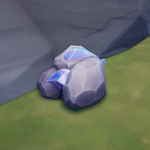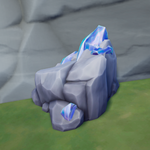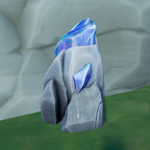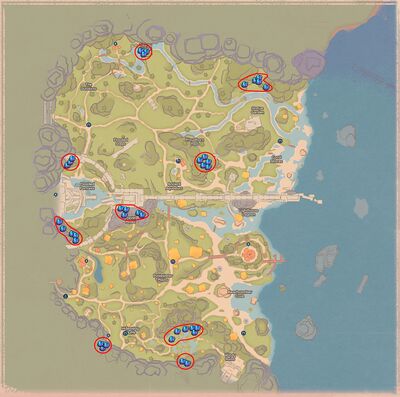Palium Ore
Jump to navigation
Jump to search
Palium Ore is a crafting material in Palia.
Description
| “ | A rock that contains palium. Can be smelted into bars for crafting. | ” |
–In-Game Item Description | ||
Location
Palium Ore can be Mined from nodes that spawn near cliff walls in Bahari Bay, as well as inside its many caves and mines. These nodes are exceptionally rare, and can usually be found in out of the way or hard to reach locations:
- Southwest mountain in the Flooded Fortress
- Northwest mountain in the Flooded Fortress
- Inside Pavel Mines, especially the shafts that can be reached from the top of the cliffs
- Cave southeast of Hassian's Grove in Hideaway Bluffs
- Cave south of the flooded ruins, between Hideaway Bluffs and the Windy Ruins
- Collapsed mine underneath the flooded ruins, southwest of Beachcomber Cove
- Top of the large geyser cave south of Proudhorn Pass
- North of the Statue Garden, near the landslide
- Cave east of Tamala's House in the Thorny Thicket
Obtaining
Palium Ore nodes come in three sizes and require a Fine Pick or higher to break. Larger nodes give more Palium Ore.
| Node Size | Picture | Amount Received | Hits to Break (Fine Pick) | Hits to Break (Exquisite Pick) |
|---|---|---|---|---|
| Small | 
|
1 - 3 | 5 | 3 |
| Medium | 
|
2 - 4 | 6 | 4 |
| Large | 
|
6 - 10 | 8 | 6 |
There is also a small chance to spawn a Scintillating Centipede when breaking a Palium Ore node of any size.
Gifting
| Villagers who like Palium Ore all the time: |
|---|
|
This excludes Weekly Wants, please confirm with the villagers if Palium Ore is desired on special occasions.
|
Related
Recipes
Palium Ore is used in the following recipes:
Quests
Palium Ore is not required for any quests.
Accomplishments
Gallery
Update History
- We’ve adjusted the location of Palium spawns.
- Palium can now spawn from any location where Iron Ore nodes also appear.
- Expect about 60% more Palium nodes now available in Bahari Bay! 💎
- This will be a first step in the direction we want to take regarding the availability of Palium nodes. While the resource is intended to be a rarer one, it’s not meant to be to the point of competitiveness. Palians should feel comfortable playing how they want to — whether it’s more of a solo style, or together with friends.
- Medium-sized Palium Nodes now drop an additional Palium Ore (so the new minimum you can get is 2).
- Medium-sized Palium Nodes now also grant more skill EXP to better match their small and large counterparts.












